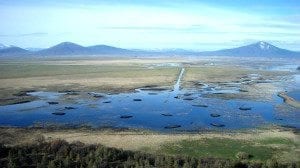McArthur Swamp Wildlife Habitat Improvement
Summary

Pacific Gas and Electric Company (PG&E) has restored approximately 500 acres of wetland habitat on PG&E property located along the Pacific Flyway, the major flyway for migratory birds in the Americas that extends from Alaska to Patagonia. The restored McArthur Swamp has seen a 20-fold increase in migratory waterfowl who are benefitting from the feeding and nesting habitat which was constructed by PG&E in collaboration with California Waterfowl Association. The McArthur Swamp Wildlife Habitat Improvement Project (WHIP) created a mosaic of meandering swales, depressions, and loafing islands that are flooded annually with water from the adjacent Big Lake, the headwaters of the Pit 1 Hydroelectric Project.
Background
The WHIP is the restoration component of the 700-acre McArthur Swamp Management Plan required by the 2003 Federal Energy Regulatory Commission (FERC) license for PG&E’s Pit 1 Hydroelectric Project (FERC No. 2687) with annual generation of 310 GWh. The McArthur Swamp is located in northeastern California in an area that is a critically important breeding and staging area for waterfowl in the Pacific Flyway. The McArthur Swamp property had been seasonal wetland before levees were built in the early 1900s to create cattle grazing land.
Challenges
PG&E had a license condition it could have met in any number of ways. Thanks to assistance from agencies and stakeholders, we developed a great project that will benefit many species for many years to come. The approach reflects PG&E’s strong commitments to collaboration and environmental stewardship.
There were numerous hurdles in the project development phase including the presence of endangered species, management of sensitive cultural resources, and design of the water source and water delivery system for the necessary flooding of the area.
McArthur Swamp and Big Lake, the primary water source for the project, are known to provide habitat to both federal and state listed wildlife species of birds and invertebrates.
Even at the late stages of project development, to address local concerns about using canal water for the restored swamp area, PG&E redesigned the project to utilize water from Big Lake. During construction, PG&E’s maintenance crew raised concerns about utilizing diesel pumps to convey water over the levees, including levee vibration, potential spills and emissions. The final solution was to install two large siphons.
Innovation
PG&E worked collaboratively throughout the design and construction phases with the U.S. Fish and Wildlife Service and California Department of Fish and Wildlife to avoid any impacts to the numerous special status species. In particular, to protect the endangered Shasta crayfish and protected rough sculpin, PG&E designed the siphon intakes with screens, and suspended the intake above the bottom of Big Lake.
To manage the flooding of the wetland area, PG&E constructed two water control structures with rip rap energy dissipaters and two large water supply siphons rather than diesel pumps. To protect the restored wetland habitat while maintaining beneficial land uses, PG&E constructed six miles of cattle exclusion fencing and three stock water troughs. Cattle grazing has become a component of the ongoing vegetation management.
Results
Through persistent collaboration and creativity, PG&E overcame numerous challenges to restore the environmental benefits of McArthur Swamp, while maintaining hydroelectric operations. After annual flooding began in 2013, the project provided high-quality feeding habitat, escape cover for adult waterfowl and hatchlings, and nesting habitat protected by water that keeps other animals from preying on eggs and hatchlings. In April 2014, CWA counted approximately 4,000-6,000 waterfowl at one time in the newly-restored McArthur Swamp, compared with less than 200 counted pre-project, demonstrating the project’s success. Birds now observed in the area include the protected bald eagle, peregrine falcon, and white-tailed kite, among more common waterfowl.
Wildlife are not the only beneficiaries of the project. When McArthur Swamp is flooded, water saturates the soil, which recharges the local ground water used as drinking water for local communities.
Just two years after completion of construction, the goals of this project have been exceeded. PG&E’s approach to work closely with stakeholders and resource agencies, use innovative ways to adapt to challenges along the way meant a successful outcome, With the help of others, PG&E is doing its part as an environmental steward to ensure wildlife thrive at McArthur Swamp. Our customers appreciate the efforts we take to improve the environment.
Stakeholder Quote
Mr. Rick Maher, Northeastern California Regional Biologist, California Waterfowl Association: “After many years of a cooperative endeavor from all the partners and PG&E’s tenacious and dedicated commitment to the WHIP, it has made for a successful restoration and enhancement of 500 acres of McArthur Swamp. This project is the epitome of how a diverse team can take a plan on paper and turn it into reality. How gratifying, as a biologist and partner of the working group, that carried this project to fruition and to witness the awesome site of thousands of birds utilizing and benefiting from the newly restored habitat within this part of the Swamp.”


